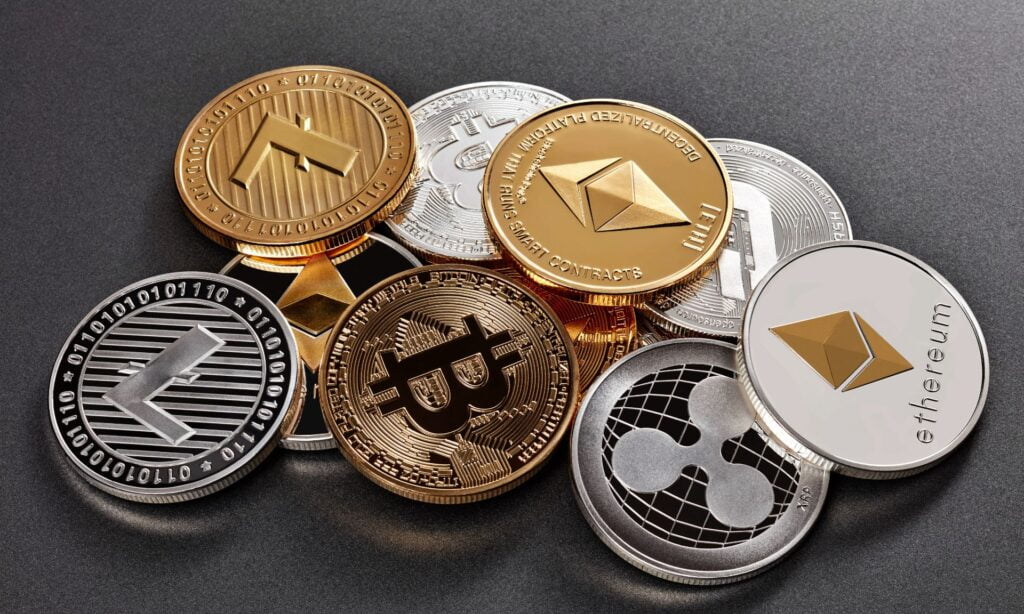Cryptocurrency has come a long way since the inception of Bitcoin in 2009. What started as a single digital currency has now evolved into a vast ecosystem with thousands of different cryptocurrencies, each serving unique purposes and catering to various needs. In this comprehensive guide, we’ll explore the diverse types of cryptocurrencies, their features, and their applications.
Payment Cryptocurrencies

Payment cryptocurrencies, also known as coins, are the most well-known and widely adopted type of cryptocurrency. These digital assets are designed to facilitate peer-to-peer transactions without the need for intermediaries like banks or payment processors.
Bitcoin, the pioneering cryptocurrency, was created as a decentralized electronic cash system. Its primary purpose is to serve as a medium of exchange, enabling users to send and receive payments securely and anonymously. Other popular payment cryptocurrencies include Litecoin, Bitcoin Cash, Monero, and Dogecoin.
These cryptocurrencies operate on their own independent blockchains, which act as public ledgers to record and verify transactions. They typically have a limited and predetermined supply, making them scarce and potentially valuable as more people adopt them.
Utility Tokens
Utility tokens are cryptocurrencies that are designed to provide access to a specific product, service, or platform within a particular ecosystem. These tokens serve as the fuel that powers decentralized applications (dApps) and protocols, enabling users to interact with and utilize the underlying technology.
One of the most prominent examples of a utility token is Ether (ETH), the native cryptocurrency of the Ethereum network. ETH is used to pay for transaction fees (known as “gas”) and to run smart contracts on the Ethereum blockchain. Other well-known utility tokens include Chainlink (LINK), Filecoin (FIL), and Basic Attention Token (BAT).
Utility tokens are often issued through initial coin offerings (ICOs) or token sales, where projects raise funds by selling a portion of their token supply to investors. The value of these tokens is typically derived from the adoption and success of the underlying project or platform.
Stablecoins
Stablecoins are cryptocurrencies designed to maintain a stable value relative to a fiat currency, such as the US dollar or the Euro, or a basket of assets. These cryptocurrencies aim to provide the benefits of blockchain technology while minimizing the volatility associated with other cryptocurrencies.
Stablecoins achieve this stability through various mechanisms, such as being backed by reserved assets (e.g., fiat currencies, commodities) or employing algorithmic strategies to control the supply and demand of the coin.
Tether (USDT) and USD Coin (USDC) are two of the most popular stablecoins, pegged to the US dollar. These stablecoins are widely used in the cryptocurrency ecosystem for trading, lending, and borrowing purposes, as well as for facilitating transactions where price stability is desired.
READ ALSO: BYDFI Cryptocurrency Exchange Review 2023
Central Bank Digital Currencies (CBDCs)
Central Bank Digital Currencies (CBDCs) are digital forms of fiat currencies issued and regulated by central banks. Unlike decentralized cryptocurrencies, CBDCs are centralized and controlled by government authorities, much like traditional fiat currencies.
CBDCs aim to combine the benefits of cryptocurrencies, such as fast and secure transactions, with the stability and trust provided by central banks. They are designed to coexist with physical cash and serve as a digital complement to traditional fiat currencies.
While still in the exploratory and development stages, several central banks around the world are actively researching and experimenting with CBDCs. Notable examples include the Digital Euro project by the European Central Bank and the Digital Yuan by the People’s Bank of China.
Meme Coins
Meme coins are a unique and often lighthearted category of cryptocurrencies that gain popularity through internet memes and social media hype. These coins are typically created as a joke or for fun, but some have managed to achieve significant market capitalization and adoption.
Dogecoin (DOGE), which started as a joke based on the popular “Doge” Shiba Inu meme, is arguably the most well-known meme coin. Despite its humble beginnings, Dogecoin has gained a substantial following and is accepted as a means of payment by various merchants and organizations.
Other notable meme coins include Shiba Inu (SHIB) and Pepe Coin (PEPE). While meme coins may not have the same technological foundations as other cryptocurrencies, they have demonstrated the power of community and social media in driving adoption and shaping the cryptocurrency market.
READ ALSO: The Best Cryptocurrency Exchanges and Finance Apps in October 2023
Non-Fungible Tokens (NFTs)
Non-Fungible Tokens (NFTs) are unique digital assets that represent ownership of a specific item, such as artwork, collectibles, or virtual real estate. Unlike traditional cryptocurrencies, which are interchangeable (fungible), each NFT is unique and non-replicable, making it a one-of-a-kind digital asset.
NFTs are built on blockchain technology, often using standards like ERC-721 and ERC-1155 on the Ethereum network. They allow creators to tokenize their digital works, providing provenance, scarcity, and ownership rights.
The NFT market has gained significant traction in recent years, with artists, musicians, and brands leveraging this technology to monetize and authenticate their digital creations. Notable NFT projects include CryptoPunks, Bored Ape Yacht Club, and NBA Top Shot.
Governance Tokens
Governance tokens are cryptocurrencies that grant holders voting rights and the ability to participate in the decision-making processes of decentralized projects or protocols. These tokens enable decentralized autonomous organizations (DAOs) to operate in a truly democratic and transparent manner.
By holding governance tokens, users can vote on proposed changes, upgrades, or new features within the associated project or protocol. The weight of each vote is typically proportional to the number of governance tokens held, incentivizing active participation and stakeholder engagement.
Examples of governance tokens include Uniswap (UNI), Maker (MKR), and Compound (COMP). These tokens play a crucial role in maintaining the decentralized and community-driven nature of blockchain projects, ensuring that key decisions align with the interests of all stakeholders.
Security Tokens
Security tokens are cryptocurrencies that represent ownership rights in traditional investment assets, such as stocks, bonds, real estate, or other financial instruments. These tokens are designed to comply with relevant securities regulations and are often subject to legal and regulatory requirements similar to traditional securities.
By tokenizing traditional assets on the blockchain, security tokens aim to provide increased liquidity, transparency, and accessibility to a wider range of investors. They also enable fractional ownership, allowing investors to purchase smaller portions of high-value assets that might otherwise be out of reach.
Notable examples of security token offerings (STOs) include Polymath (POLY), Securitize (SXDT), and Harbor (HRT). However, it’s important to note that security tokens are still a relatively new concept, and the regulatory landscape surrounding them continues to evolve.
To Recap: Embracing the Diverse Crypto Ecosystem
The cryptocurrency landscape has evolved into a rich tapestry of digital assets, each serving unique purposes and catering to diverse needs. From payment cryptocurrencies that facilitate global transactions to utility tokens that power decentralized applications, the variety of cryptocurrencies showcases the boundless potential and creativity of the blockchain ecosystem.
As the adoption of cryptocurrencies continues to grow, we can expect to see even more innovation and diversification within this space. Stablecoins and CBDCs hold the promise of bridging the gap between traditional finance and the digital world, while NFTs revolutionize the way we perceive ownership and value in the digital realm.
Governance tokens empower decentralized communities, fostering transparency and shared decision-making, while security tokens unlock new opportunities for asset tokenization and fractional ownership.
Navigating this diverse crypto landscape requires a deep understanding of the underlying technologies, use cases, and potential risks and rewards associated with each type of cryptocurrency. By embracing the diversity and constantly evolving nature of the crypto ecosystem, we can unlock new avenues for innovation, collaboration, and economic empowerment.
CoinStats is a powerful crypto portfolio tracker that can help you keep track of your holdings across different types of cryptocurrencies, providing real-time insights and analytics to inform your investment decisions.
Binance is a leading cryptocurrency exchange that offers a wide range of trading pairs, including various types of cryptocurrencies, enabling you to diversify your portfolio and explore the opportunities within this dynamic market.
Coinbase is another popular cryptocurrency exchange that not only supports a variety of cryptocurrencies but also provides educational resources and tools to help you navigate the complexities of the crypto world.
Embrace the diversity, stay informed, and embark on a journey through the ever-evolving landscape of cryptocurrencies, where innovation and disruption intersect to shape the future of finance and beyond.
Frequently Asked Questions (FAQs)
What is the difference between coins and tokens?
Coins are cryptocurrencies that operate on their own independent blockchain, while tokens are built on top of existing blockchains like Ethereum. Coins serve as the native currency of their respective blockchain networks, while tokens represent various assets, utilities, or rights within a specific ecosystem.
Are all cryptocurrencies decentralized?
No, not all cryptocurrencies are decentralized. While many popular cryptocurrencies like Bitcoin and Ethereum are designed to be decentralized, there are also centralized cryptocurrencies like Central Bank Digital Currencies (CBDCs) that are issued and controlled by central authorities.
Can cryptocurrencies be used for illegal activities?
While cryptocurrencies themselves are not inherently illegal, they can be misused for illicit purposes, just like traditional currencies. However, many cryptocurrencies prioritize transparency and traceability, making it easier to track and prevent illegal activities.
What is the difference between a stablecoin and a Central Bank Digital Currency (CBDC)?
Stablecoins are typically issued by private companies or organizations and are designed to maintain a stable value relative to a fiat currency or a basket of assets. CBDCs, on the other hand, are digital forms of fiat currencies issued and regulated by central banks, serving as a digital complement to traditional physical cash.
Are meme coins a good investment?
Meme coins are highly speculative and often lack strong fundamentals or real-world use cases. While some meme coins have experienced significant price surges due to social media hype, they are generally considered high-risk investments and should be approached with caution.





